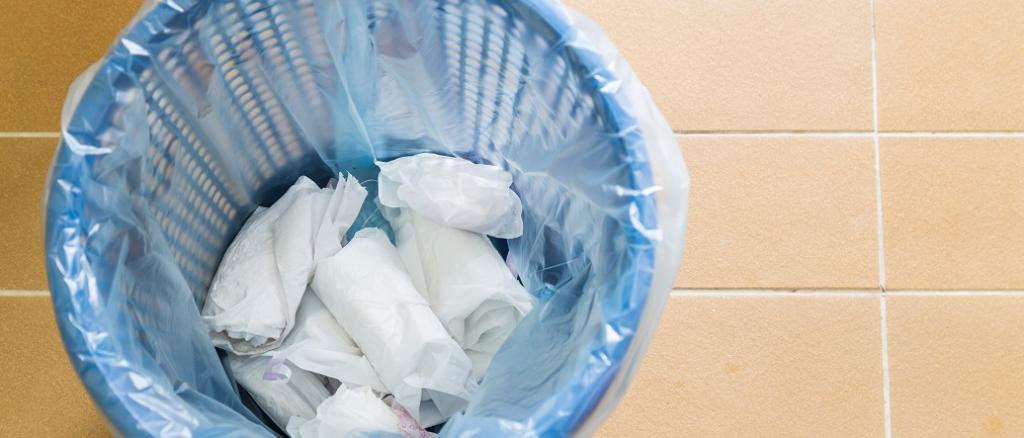Editor’s Note: This month, that is May 2020, FII’s #MoodOfTheMonth is Menstrual Health, where we invite various articles about various experiences that revolve around menstruation or the absence of the same. If you’d like to share your article, email us at pragya@feminisminindia.com.
Arunachalam Murugantham, better known as ‘Pad-Man’ after bollywood actor Akshay Kumar’s blockbuster film, brought about a revolutionary invention that made the use of sanitary napkins in rural India possible. With low-cost options of sanitary napkins being developed to promote hygiene and women’s safety in rural areas, it seems there is one part of the problem that has still not been addressed. The part that comes after the use of these sanitary napkins: menstrual waste disposal.
India recently went through a cleanliness wave campaign with the Swachh Bharat Abhiyan going right down to community levels. While the tangible impact of the campaign can be debated, the Swachh Bharat movement not only managed to create awareness about the need for sanitation at length but also launched a massive call-to-action which for the first time directly spoke to the citizens of the country and held them responsible. However, there was one issue that remained shrouded in silence due to the social stigma and taboos surrounding it, the issue of menstrual waste disposal.
This particular waste disposal issue still largely remains a ‘silent problem’ in India. According to Menstrual Health Alliance of India (MHAI), the number of menstruating women in India who use disposable sanitary napkins stands at a staggering 121 million. Disposable sanitary napkins are made of 90% plastic and keeping in mind the adhesives, packing, etc., each pad is equivalent to around 4 plastic bags. If we estimate the number of pads used per cycle to a modest 8, it equates to roughly 12 billion pads disposed per year. According to a report, each of these pads can take roughly 500 to 800 years to decompose due to their largely plastic ingredients.
Disposable sanitary napkins are made of 90% plastic and keeping in mind the adhesives, packing, etc., each pad is equivalent to around 4 plastic bags. If we estimate the number of pads used per cycle to a modest 8, it equates to roughly 12 billion pads disposed per year. According to a report, each of these pads can take roughly 500 to 800 years to decompose due to their largely plastic ingredients.
Current Methods of Disposal
In urban areas, majority of the women turn to commercial sanitary napkins which are less environment friendly than most other options. Due to the lack of awareness around sanitary or menstrual waste disposal and the absence of laws to force segregation, most women dispose of used sanitary napkins along with the rest of the domestic waste. While waste is usually segregated into dry and wet waste according to waste management guidelines, separation of menstrual waste is seldom considered. In urban areas, where even sanitary napkins are wrapped in more secrecy than the ‘routine’ leers of men, we often prefer to simply throw away the waste instead of discussing or caring about its disposal due to the stigma around the conversation. This ‘out of sight, out of mind’ solution that most of us in cities adopt needs an urgent re-evaluation.
In most rural areas, where women are still subjected to the prejudice of being considered impure while menstruating, this issue is further exacerbated. Lack of access to proper disposal systems and awareness forces them to burn or bury their pads in community pits where degradation does not occur. This has long term implications on the health of the land. For women who live close to water bodies, the easy solution is to throw the pads into the water, causing massive health and environment hazards. Due to limited awareness, schools and colleges which do not have proper disposal systems force students to throw their used pads into toilets thereby causing choking.
Laws Relating to Sanitary waste
India produces 9000 tonnes of Sanitary waste every year. This is equivalent to weighing the Statue of Unity. Four times. Despite the massive waste generated in the country, India does not have separate laws governing the disposal of sanitary waste. Only two cities – Bengaluru and Pune – have laws on segregation of sanitary waste wherein the sanitary waste must be separately handed over along with the dry and wet waste of the household.
According to the Solid Waste Management Rules, 2016, menstrual waste is classified as “sanitary waste” under the ambit of solid waste. The method for disposing sanitary waste is incineration and the state has pushed for low-cost incinerators in various schools and women’s complexes. The guidelines for menstrual waste disposal also further elucidate the responsibilities of the authorities and the manufacturers in ensuring proper disposal. Needless to say, these are not always followed. While the guidelines suggest that the manufacturers not only provide a pouch for safe disposal of the pad but also assist the local authorities in creating awareness and handling disposal of their products, this is seldom done.
In most rural areas, where women are still subjected to the prejudice of being considered impure while menstruating, this issue is further exacerbated. Lack of access to proper disposal systems and awareness forces them to burn or bury their pads in community pits where degradation does not occur. This has long term implications on the health of the land. For women who live close to water bodies, the easy solution is to throw the pads into the water, causing massive health and environment hazards.
WHO guidelines suggest that sanitary waste be incinerated at a temperature greater than 800 degrees. This is because when plastic polymers like disposable pads are burnt at lower temperatures, asphyxiant and irritant gases into the atmosphere. However, the low-cost incinerators that are installed in schools and women’s community complexes burn the waste at a much lower temperature leading to the release of toxic gases like furins and dioxins. WHO warns that these gases can travel over great distances and can cause impairment to the immune system.
Also read: Why The PadMan Challenge Does Not Really Combat Menstruation Stigma
Stigma leading to slow solutions
Menstruation has historically been seen as an ‘impure’ affliction that the female gender has been cursed with. Women in a majority parts of the country are still not allowed to enter kitchens and temples while menstruating.
With conversations around the topic still remaining largely a tabooed topic, especially in the presence of men, the road to solutions for several menstrual topics has been filled with obstacles. The stigma surrounding menstruation leads to shame and embarrassment for women and they prefer to get rid of the ‘evidence’ by throwing it away in the most convenient place (pit, dustbin or pond) or washing the pieces of cloth used in the dead of night when everyone is asleep. It also leads to women not discussing or adopting solutions for this problem of waste disposal. The Ministry for Women and Child Development did a great job by educating young women in rural villages about the need for maintaining proper menstrual hygiene but perhaps it needs to expand to include the need for proper menstrual waste disposal as well.
“The stigma surrounding menstruation leads to shame and embarrassment for women and they prefer to get rid of the ‘evidence’ by throwing it away in the most convenient place (pit, dustbin or pond) or washing the pieces of cloth used in the dead of night when everyone is asleep”
With conversations around the topic still remaining largely a tabooed topic, especially in the presence of men, the road to solutions for several menstrual topics has been filled with obstacles. The stigma surrounding menstruation leads to shame and embarrassment for women and they prefer to get rid of the ‘evidence’ by throwing it away in the most convenient place (pit, dustbin or pond) or washing the pieces of cloth used in the dead of night when everyone is asleep. It also leads to women not discussing or adopting solutions for this problem of waste disposal.
What needs to be done?
- Urgent need for laws concerning menstrual waste: It is no longer sufficient to leave the disposal of sanitary napkins to decentralised incineration methods. Sanitary napkins need to be classified under biomedical waste and undergo centralized incineration techniques to ensure pollution-free disposal
- Alternatives to pads: On an individual level, women need to be educated about their options and encouraged to make the more eco-friendly choice.
- Segregation: Enforcing stringent rules to promote and ensure segregation of menstrual waste will not only make identification and incineration of the waste easier but will also preserve the hygiene and dignity of the waste collectors. One initiative that explored how this can be achieved was the RedDot Campaign which encouraged people to mark their sanitary waste with a red dot making it easily recognizable to the garbage collectors. Such solutions need to be explored and enforced by law.
- Education & Awareness: Highlighting the need for proper menstrual waste disposal either through a separate public awareness campaign or including it in the awareness campaigns that are used to encourage women to use sanitary napkins and maintain menstrual hygiene.
Conclusion
Amidst the Covid-19 pandemic, as we reevaluate our environmental impact, the government as well as the citizens need to look at this massively ignored problem of menstrual waste disposal and work together towards concrete, sustainable solutions. Each woman who decides to switch to a more eco-friendly sanitary product can save up to 125 kg of waste in her menstruating years!
Also read: Menstruation Is Natural. Myths Around Menstruation Are Social Constructs.
Proper sanitary waste disposal laws and novel methods of recycling menstrual waste are the need of the hour. It is way past time we focus on this largely ‘silent problem’ and make active decisions to reduce our menstrual waste.
Featured Image Source: Down To Earth
About the author(s)
Vaishnavi Singh is an alumnus of The Young India Fellowship at Ashoka University. She is deeply interested in exploring the less understood aspects of something as vast and ever-changing as feminism. Vaishnavi is an opinionated introvert who loves travelling, watching movies and reading everything that she disagrees with.




